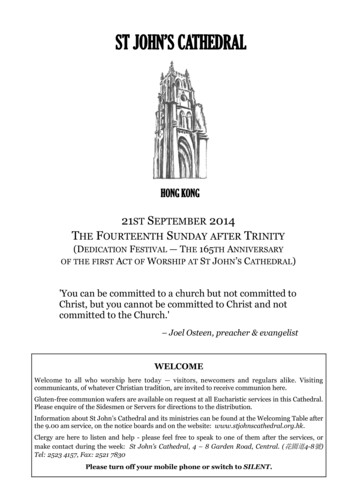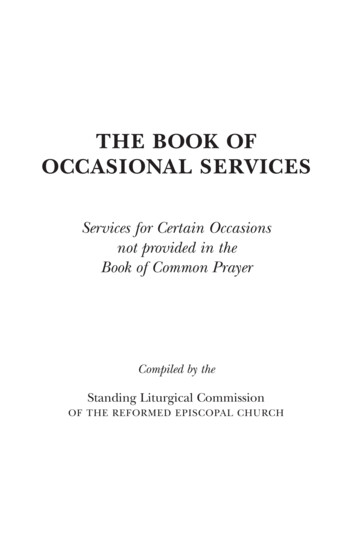
Transcription
Moraes et al. Stem Cell Research & Therapy (2016) 7:97DOI 10.1186/s13287-016-0359-3RESEARCHOpen AccessA reduction in CD90 (THY-1) expressionresults in increased differentiation ofmesenchymal stromal cellsDaniela A. Moraes1,6, Tatiana T. Sibov3, Lorena F. Pavon3, Paula Q. Alvim1, Raphael S. Bonadio1,Jaqueline R. Da Silva1, Aline Pic-Taylor1, Orlando A. Toledo2, Luciana C. Marti4, Ricardo B. Azevedo1and Daniela M. Oliveira1,5*AbstractBackground: Mesenchymal stromal cells (MSCs) are multipotent progenitor cells used in several cell therapies.MSCs are characterized by the expression of CD73, CD90, and CD105 cell markers, and the absence of CD34, CD45,CD11a, CD19, and HLA-DR cell markers. CD90 is a glycoprotein present in the MSC membranes and also in adultcells and cancer stem cells. The role of CD90 in MSCs remains unknown. Here, we sought to analyse the role thatCD90 plays in the characteristic properties of in vitro expanded human MSCs.Methods: We investigated the function of CD90 with regard to morphology, proliferation rate, suppression of T-cellproliferation, and osteogenic/adipogenic differentiation of MSCs by reducing the expression of this marker usingCD90-target small hairpin RNA lentiviral vectors.Results: The present study shows that a reduction in CD90 expression enhances the osteogenic and adipogenicdifferentiation of MSCs in vitro and, unexpectedly, causes a decrease in CD44 and CD166 expression.Conclusion: Our study suggests that CD90 controls the differentiation of MSCs by acting as an obstacle in thepathway of differentiation commitment. This may be overcome in the presence of the correct differentiationstimuli, supporting the idea that CD90 level manipulation may lead to more efficient differentiation rates in vitro.Keywords: Mesenchymal stem cells, Mesenchymal stromal cells, CD90, Thy-1, Fibroblast, DifferentiationBackgroundMesenchymal stromal cells (MSCs) are multipotent progenitor cells identified by their plastic-adherence whenmaintained under standard culture conditions, selfrenewability, and differentiation into several mesodermallineages [1–3]. MSCs are classically able to differentiateinto osteoblasts, adipocytes, and chondroblasts in vitro[4]. Since their initial description as colony-forming cellunits present in the bone marrow [5], MSCs have beenisolated from many tissue sources such as placenta [6],dental pulp [7], tendons [8], scalp tissue [9], adipose tissue[10], umbilical cord blood [11], umbilical cord perivascular* Correspondence: dmoliveira@unb.br1Departamento de Genética e Morfologia, Universidade de Brasília, Brasília,DF, Brazil5IB-Departamento de Genética e Morfologia, Universidade de Brasília - UNB,Campus Universitário Darcy Ribeiro, Asa Norte, Brasília CEP 70910-970, BrazilFull list of author information is available at the end of the articlecells [12], umbilical cord Wharton’s jelly [13], synovialmembrane [2], amniotic fluid [14], and breast milk [15].Due to their relatively easy isolation, multi-differentiationpotential, low antigenicity, and good proliferation/expansion in cell culture, MSCs are considered ideal candidatesfor cell-based regenerative therapies [16]. Based on theminimal criteria established by the International Societyfor Cellular Therapy (ISCT), human MSCs are identifiedby a combination of high CD105, CD73, and CD90 expression, and very low/no CD34, CD45, CD11a, CD19,and HLA-DR expression [4, 17]. Currently, there is nounique cell marker capable of solely isolating and definingMSCs. The observation that only a subpopulation ofplastic-adherence isolated MSCs show multipotency [18]has led to a search for an ideal and definitive single MSCmarker that would not only be specific to MSC, but wouldallow direct correlation with stemness [19]. 2016 The Author(s). Open Access This article is distributed under the terms of the Creative Commons Attribution 4.0International License (http://creativecommons.org/licenses/by/4.0/), which permits unrestricted use, distribution, andreproduction in any medium, provided you give appropriate credit to the original author(s) and the source, provide a link tothe Creative Commons license, and indicate if changes were made. The Creative Commons Public Domain Dedication o/1.0/) applies to the data made available in this article, unless otherwise stated.
Moraes et al. Stem Cell Research & Therapy (2016) 7:97Although CD90 and STRO-1 are broadly used to identify MSCs, neither of them is specific to MSCs [20–22].STRO-1 is only expressed in a low percentage of MSCs.Some authors also discuss the absence of this marker inMSCs from all tissue sources [12, 19, 23], and it remainsunclear, in the current literature, whether STRO-1 expression correlates to MSC stemness. On the other hand,CD90 is highly expressed in all MSCs, irrespective of thesource, and it is a good marker for CFU-F enrichment[24]. High CD90 expression has also been related to theundifferentiated status of MSCs, since a decrease in CD90level can be correlated with the temporal lineage commitment in vitro [25].CD90, or Thy-1, is a 25–37 KDa glycosylphosphatidylinositol (GPI)-anchored glycoprotein [26]. CD90 was firstdetected in mice T cells [27] and later found to beexpressed in thymocytes, T cells, neurons, hematopoieticstem cells, cancer stem cells, endothelial cells, and fibroblasts [28]. Although it has been shown that CD90 is conserved among different species, its function seems to varyaccording to cell type [29]. CD90 has been reported toparticipate in T-cell activation [30], neuritis outgrowthmodulation [31], vesicular release of neurotransmitter atthe synapse [32], astrocyte adhesion [33], apoptosis in carcinoma cells [34], tumour suppression [35–37], woundhealing [38], fibrosis [39, 40], and fibrogenesis [41]. Furthermore, it regulates fibroblast focal adhesion, cytoskeleton organization, and cell migration [42]. In mousemodels, activation of CD90 expression can be observed ininflammation, wound healing, and tumour development[43]. Recent studies suggest that CD90 has a role in oncogenesis, and it has also been proposed as a marker for cancer stem cells (CSCs) in various malignancies [44–51].Despite an increasing number of studies suggestingCD90 participation in MSC self-renewal and differentiation [52], its function in MSC biology remains unknown. The unveiling of the function of CD90 in MSCsmay further facilitate the in vitro manipulation of MSCsand consequently MSC-based therapies for regenerativemedicine. In this study, we investigated the function ofCD90 in MSC biology. To achieve this objective, we analysed the effect of CD90 knockdown on proliferation,morphology, and differentiation of human MSCs.MethodsSubjects and cell cultureThe cells were obtained with the approval of the EthicsCommittee of the Faculty of Health Sciences at the University of Brasilia (Brazil) and University of São Paulo(Brazil). MSCs were isolated from healthy human tissuesand cultured as previously reported. In the presentstudy, we obtained MSCs from three different tissuesources: dental pulp [7] (three donors), adipose tissue[10] (two donors), and amniotic fluid [14] (two donors).Page 2 of 14After isolation, cells were cryopreserved and stored in liquid nitrogen. For the assays we used cells that werestored for no longer than 1 year. Briefly, cells werethawed and expanded in a regular medium of Dulbecco’smodified Eagle’s medium (DMEM-LG; Sigma Chemical),supplemented with 10 % fetal bovine serum (FBS;Gibco), 100 units/ml penicillin, 100 mg/ml streptomycin(Gibco), and 10 μl/ml L-glutamine (Gibco) at 37 C, 5 %CO2 [1]. The medium was changed every 48 h.Lentiviral transduction for CD90 depletionFor lentiviral transduction, MSC isolates (a total of sevensamples at cell passage 2) were cultured in a 75-cm2flask in medium containing 10 % FBS (Gibco), 100units/ml penicillin, 100 mg/ml streptomycin (Gibco),10 μl/ml L-glutamin (Gibco) at 37 C, 5 % CO2. Whencells reached a confluence of 60 %, transduction wasperformed in the presence of 8 μg/ml Polybrene (SigmaAldrich) according to the manufacturer’s instructions(Santa Cruz Biotechnology). CD90 small hairpin(sh)RNA-expressing lentivirus (shRNA CD90) or nontargeting shRNA-expressing scramble sequences of RNA(shRNA control) were then added to the cells at a multiplicity of infection (MOI) of 10. The medium was changed after 24 h. Three days after transduction, stableclones of MSCs expressing CD90-shRNA (shRNA CD90MSC) and control shRNA (shRNA control MSC) wereselected using 5 μg/ml Puromycin (Sigma-Aldrich) for10 days. The medium was changed every 48 h.Real-time quantitative PCRTotal RNA was extracted from MSCs using IllustraRNAspin Mini (GE Healthcare), according to themanufacturer's guidelines. cDNA was prepared withHigh-Capacity cDNA Reverse Transcription (AppliedBiosystems) and used as templates for polymerasechain reaction (PCR). The Kit Power Up SYBR GreenMaster Mix (Applied Biosystems) was used to quantify CD90 gene expression by quantitative real-time(qRT)-PCR under conditions recommended by themanufacturer and using the following primers:CACCCTCTCCGCACACCT (forward) and CCCCACCATCCCACTACC (reverse). For normalization of thedata, the housekeeping gene glyceraldehyde 3phosphate dehydrogenase (GAPDH) mRNA was used(forward primer: AGAAGGCTGGGGCTCATTTG; reverse primer: AGGGGCCATCCACAGTCTTC). qRTPCR was performed with the StepOne Plus Real-TimePCR System. A standard curve was generated foreach primer pair, and genes of interest were assigneda relative expression value interpolated from thestandard curve using the threshold cycle. All expression values were normalized against GAPDH. All amplifications were done in triplicate.
Moraes et al. Stem Cell Research & Therapy (2016) 7:97Magnetic separation of the MSCs for negative selection ofCD90Cell purification was performed according to the manufacturer’s instructions (MiltenyiBiotec). To isolate theCD90-negative MSC population, shRNA CD90 MSCswere incubated with anti-CD90-coupled magnetic beads(MiltenyiBiotec, Germany) for 15 min at 4 C, rinsed, andplaced in a column. The negative fraction (CD90-negativeMSCs) was collected, and cell purity checked by flow cytometry (FACSVERSE-BD Biosciences, San Jose, CA,USA) and FlowJo analysis software (TreeStar, Ashland,OR, USA).Flow-cytometric analysisCommercially available monoclonal antibodies were usedfor MSC immunophenotyping following the manufacturer’s instructions. Subcultures at passage 3 were used forthe flow-cytometric analysis. MSCs were lifted using TrypLE (Invitrogen, Carlsbad, CA, USA) and centrifuged for5 min at 1000 rpm. The supernatant was discarded by aspiration and the cells incubated for 30 min in a dark environment in a flow cytometry buffer (phosphate-bufferedsaline (PBS), 2 % FBS) containing monoclonal antibodiesagainst cell surface molecules and their respective isotypecontrols. The following antibodies were used: CD14-FITC;CD29-PE; CD31-PE; CD34-PE; CD44-PE; CD73-PE;CD90-APC; CD90-FITC; CD106-FITC; CD166-PE andCD166-PerPC-Cy5.5; CD45-PerCP-Cy5.5; HLA-DRPerCP-Cy5.5 (Biosciences); and CD105-PE (clone 8E11;Chemicon, Temecula, CA, USA). Mouse IgG1-FITC,IgG1-PE, IgG1 PerCP-Cy5.5, IgG1-APC (Biosciences), andIgG2A-FITC (AbDSerotec, UK) were used as isotype controls. Cells were analysed using a fluorescence-activatedcell sorter (CyFlowSpace-Partec, Germany; FACSVERSEBD or FACSARIA-BD, both from BD Biosciences) and thedata analysed using FlowJo analysis software (TreeStar).MSC morphology analysisTransduced and non-transduced MSCs at passage 3 wereplaced, in triplicate, in 24-well culture plates (5 104 cells/well). After cell concentration reached a confluence of70 %, media were removed and the cells were washed withPBS and fixed with a 4 % paraformaldehyde solution for15 min at room temperature. Cells were then washed withPBS, stained with Kit Instant Prov (NewProv, Brazil) andrewashed with PBS. Cell morphology (shape and size) wasthen analysed under an Axiovert inverted microscope(Zeiss, Germany) and EVOS FL cell imaging system (LifeTechnologies, Eugene, OR, USA).Growth assayFor the assessment of growth characteristics, MSCs (1 105 cells, at passage 3 after transduction, passage 5 afterisolation) were seeded in 75-cm2 culture flasks in MSCPage 3 of 14culture medium. Every 48 h, three replicate flasks weretrypsinised and viable cells counted with a haemocytometer. MSC viability was evaluated by Trypan blue exclusion assay.Lymphocyte proliferation assayPeripheral blood mononuclear cells were isolated fromperipheral blood and separated using the standardmethod with Ficoll-Paque PLUS (Amersham Biosciences, Uppsala, Sweden). The mononuclear cells werewashed twice with PBS buffer. Cells were then countedin an automated cell counter (2.0 Scepter, Millipore), resuspended to a final concentration of 104 cells/ml andlabelled with CFSE (Sigma-Aldrich). The CFSE was adjusted to a final concentration of 5 μM and incubatedfor 10 min at 37 C. The reaction was stopped by addingRPMI with 10 % FBS. In immediate succession, 2 104lymphocytes were cultured with or without 5 104MSCs previously adhered to the bottom of a 24-wellplate in a total volume of 1 ml per well of RPMI with10 % FBS medium. To evaluate the lymphocyte proliferation rate in the presence of MSCs, cell suspensionswere activated with a phytohaemagglutinin (PHA;Sigma, USA) stimulus at a final concentration of 1 μg/ml in cell culture and maintained at 37 C with 5 % CO2for 5 days for subsequent assessment by flow cytometry(CyFlowSpace-Partec, Germany) and the FlowJo analysissoftware (TreeStar) [53]. Suspension cells were stainedwith CD8-PE antibody (Biosciences), and lymphocyteproliferation was measured according to CFSE stainingon gated population.In vitro differentiation assaysTo evaluate the differentiation potential of MSCs, cellswere subjected to in vitro osteogenic and adipogenic differentiation according to the established protocols [1].Transduced and non-transduced MSCs at passage 4(passage 2 after transduction) were seeded in 24-wellplates at a density of 5 104 cells/well. When a confluence of 80 % was achieved, the regular medium was replaced with an induction medium, which was refreshedevery 72 h for 21 days. Cells cultured in regular mediumwere used as controls.Osteogenic differentiationMSCs were placed in 24-well plates at a density of 5 104cells/cm2 the previous day and then treated with osteogenic supplements as previously described [1] for 21 days.The osteogenic medium contained 100 nM dexamethasone (Sigma-Aldrich), 10 mM 2-β-glycero-phosphate(Sigma-Aldrich), and 50 μM of L-ascorbic acid-2phosphate (Sigma-Aldrich). Osteogenic differentiation wasevaluated by alkaline phosphatase (ALP) activity, calciumconcentration determination, and colorimetric Alizarin red
Moraes et al. Stem Cell Research & Therapy (2016) 7:97staining. Mineralized matrix formation after osteogenic differentiation was detected as previously described [1]. Samples were fixed with 4 % paraformaldehyde for 15 min,rinsed in PBS, and dyed for 20 min with 40 mM AlizarinRed solution (Sigma-Aldrich) at pH 4.2 and roomtemperature. Cells were washed five times with distilledwater, followed by an immediate 15-min rinse with PBS toreduce non-specific dying. The resulting samples wereanalysed and photographed under an Axiovert invertedmicroscope (Zeiss, Germany). To determine alizarin redconcentration, the samples were exposed to 10 mM sodium phosphate containing 10 % cetylpyridinium chloride(Sigma-Aldrich) at pH of 7.0 for 15 min at roomtemperature. The Alizarin Red concentration was determined by measuring absorption at 562 nm using a spectrophotometer (SpectraMax M2, Molecular Devices, USA).Results were expressed as a percentage of the respectivecontrols, which were normalized to 100 % [54]. Lysate alkaline phosphatase activity was measured spectrophotometrically using a Sigmafast p-nitrophenyl phosphate kit(Sigma-Aldrich). For ALP assays, cells were washed withPBS and lysed in 0.05 % Triton X-100 through three cyclesof freezing and thawing. A lysate aliquot was incubatedwith p-nitrophenyl phosphate substrate (p-NF) at 37 C for30 min. The reactions were stopped by adding 5 μl 1 NNaOH and absorbance measured at 405 nm using a spectrophotometer (SpectraMax M2, Molecular Devices) [55].A pattern curve of p-NF was established in order to determine the enzymatic activity. Samples were normalized andtotal protein quantification determined by the Lowrymethod [56].The quantitative levels of calcium in cell samples weredetermined for both osteogenic differentiation-induced andnon-induced cells. Supernatant calcium concentration wasdetermined by colorimetry using the ortho-cresolphthaleincomplexone (o-CPC) method [57]. Cells were trypsinised,resuspended in PBS, and then reacted with a calcium reagent containing 0.69 mol/l ethanolamine buffer, 0.2 % sodium azide, 0.338 mmol/l 0-cresolphthalein complexone,and 78 mmol/l 8-hydroxynquinoline-13. Cell reactionswere read by a spectrophotometer (Advia2400, Siemens).Adipogenic differentiationFor adipogenic induction, cells were seeded in 24-wellplates at a density of 5 104 cells/cm2. When the cellsreached confluence, they were treated with an adipogenic induction medium containing 5 mg/ml insulin,5 mmol indomethacin, 1 mmol dexamethasone, and0.5 mmol/l isobutyl-1-methylxanthine (all from SigmaAldrich) in regular medium. Adipocyte formation wasmonitored by the appearance of lipid droplets under amicroscope. After the induction period, cytochemicalanalysis of the differentiated and control cells was performed by conventional optical microscopy. The cellsPage 4 of 14were fixed in 4 % formaldehyde for 15 min, rinsed inPBS, and dyed for 30 min with 0.5 % Oil Red O (SigmaAldrich) in ethanol. Cells were subsequently washed fivetimes with distilled water to remove any excess dye.Quantification of lipid accumulation was achieved byextracting Oil Red-O from stained cells with isopropanoland measuring the OD of the extract at 510 nm using aSpectramax M2 spectrophotometer (Molecular Devices)[58].Statistical analysisStatistical analysis was performed using the softwareGraphPad (San Diego, CA, USA). Quantitative datawere expressed as mean standard deviations (SD) andstatistical analyses of variance (ANOVA). Multiple comparisons were performed with Tukey's HSD test whenappropriate. Findings with p 0.05 were considered statistically significant.ResultsMSC isolates and purityMSCs were obtained from dental pulp (DPSC; three donors), amniotic fluid (AF-MSC; two donors), and adiposetissue (ADSC; two donors). The success rate of isolatingMSCs from all tissues was 100 %. Cells from all threesources (a total of seven isolates) contained a high number of adherent MSC-like cells which proliferated rapidlyin number. Analysis of positive and negative characteristics for human MSC surface antigens by flow cytometryfor cultured MSCs showed a high purity ( 97 %) of thecells (Additional file 1: Table S1).Analysis of the CD90 downregulated expression effect inMSCsTo initiate our study, we reduced CD90 expression inMSCs (DPSC, AF-MSC, and ADSC) by transducingcommercially available lentiviruses expressing threeCD90 shRNAs. After transduction, the MSC lines stablyexpressing shRNA CD90 and shRNA control were established by antibiotic selection. To confirm CD90 reduction, unmodified/non-transduced MSCs, shRNA CD90MSCs, and shRNA control MSCs were analysed by flowcytometry (Fig. 1a and b) and qRT- PCR (Fig. 1c). Nontransduced MSCs and shRNA control MSCs showed thesame level of CD90 expression (mean 98 %), whereasshRNA CD90 MSCs presented reduced CD90 expression(mean 23.9 %) (Fig. 1b). Transduction and establishmentof shRNAs (CD90 and control) expressing MSCs wereperformed using samples from all tissues, with similarlevels of reduction in CD90 expression observed in allsamples (Additional file 1: Table S1). qRT- PCR confirmed that shRNA CD90 used here effectively reducedtranscript levels of CD90 (Fig. 1c).
Moraes et al. Stem Cell Research & Therapy (2016) 7:97Page 5 of 14Fig. 1 Reduction of CD90 in MSCs. a Non-transduced mesenchymal stromal cells (MSC) and MSCs transduced with lentiviral particles expressingshort hairpin (sh)RNA against CD90 (shRNA CD90 MSC) were analysed by flow cytometry. An accentuated decrease in CD90 expression is observedin shRNA CD90 MSC (thick line), whereas non-transduced MSCs (slim line) expressed high levels of CD90. The shaded histogram indicates stainingwith isotype control antibody. Representative histograms from dental pulp MSCs are shown. b Significant decrease of CD90 median fluorescenceintensity (MFI) on shRNA CD90 MSCs when compared to non-transduced MSCs. (MFI MFI marker – MFI isotype). Bar graphs represent the averagemean fluorescence intensity as the median SD of CD90-FITC on cell lines used in this work; n 7; ****p 0.001. c Relative mRNA expression levels ofCD90 in MSC, shRNA control MSC, and shRNA CD90 MSC had consistently low expression of CD90. Data are presented as mean SD of experimentsperformed in triplicate; *p 0.05Since CD90 expression was not completely ablated inshRNA CD90 MSCs, we submitted shRNA CD90 MSCsamples to magnetic-activated cell sorting and collectedthe post-separation CD90-negative fraction (subsequently termed CD90-negative MSCs). CD90-negativeMSCs were characterized by flow cytometry to verifypurification success. Flow cytometry analysis confirmedthat the CD90-negative MSCs samples expressed lowerlevels of CD90 than shRNA CD90 MSCs (Fig. 2).Morphology and growth kineticsIn our cellular morphology analysis of the cells used inthis study, we observed no differences in the shape andsize of MSCs, shRNA control MSCs, shRNA CD90MSCs, CD90-negative MSCs, and non-transduced MSCs(Fig. 3a). The shRNA CD90 MSCs and CD90-negativeMSCs derived from all three sources displayed characteristic MSC/fibroblast-like morphology. We also observed thatshRNA CD90 MSCs and CD90-negative MSCs maintainedtheir capacity to form colonies for up to 10 passages, suggesting that CD90 is not involved in the maintenance ofMSC cell morphology and colony-forming ability.In order to assess the role of CD90 in MSC proliferationrate, cell growth curves for MSCs, shRNA control MSCs,shRNA CD90 MSCs, CD90-negative MSCs, and nontransduced MSCs at the same corresponding cell passage(cell passage 5) were conducted in parallel (Fig. 3b). Analysis of the area under the curve showed no significant difference in proliferation rates. The trypan blue exclusionassay also showed no difference in cell viability.Lymphocyte proliferation analysisWe also investigated whether CD90 expression in MSCswould affect the inhibitory effect of MSCs on nonspecific mitogen-stimulated lymphocytes in an in vitroassay. The assay showed that shRNA CD90 MSCs andCD90-negative MSCs suppressed peripheral bloodmononuclear cell proliferation to the same extent asMSCs and shRNA control MSCs and non-transducedMSCs (Fig. 4a and b), indicating that a reduction in theexpression of CD90 does not affect the characteristic immunosuppressive effect of MSCs on lymphocyte proliferation. Further analysis shows that ablation of CD90 onMSCs also does not affect the percentage of proliferatedCD8 T cells (Fig. 4c).Flow cytometry immunophenotypingWe further analysed the cell expression of the MSCmarker panel. As expected, and as for non-transducedMSCs, shRNA control MSCs, shRNA CD90 MSCs, andCD90-negative MSCs were negative for the expressionof the following markers: CD14, CD31, CD34, CD45,CD106, and HLA-DR, but they were positive for CD29,CD73, and CD105 (Additional file 1: Table S1 and Additional file 2: Figure S1). Surprisingly, we found a reduction in the expression of the CD44 and CD166 markersin shRNA CD90 MSCs, suggesting that the CD90 reduction is linked to the decrease in CD166 and CD44 expression (Fig. 5a and b). These reductions were observedin MSCs from all three sources (Fig. 5a).
Moraes et al. Stem Cell Research & Therapy (2016) 7:97Page 6 of 14Fig. 2 CD90-negative selection of shRNA CD90 MSCs by magnetic-activated cell sorting. Mesenchymal stromal cells (MSCs) expressing shorthairpin (sh)RNA CD90 (shRNA CD90 MSC) were magnetically labelled with CD90 microbeads, and MSC populations negatively selected for CD90(CD90-negative MSCs). a Histogram superposition: isotype control (shaded histogram grey), non-transduced MSCs (black slim line), shRNA controlMSCs (grey line), shRNA CD90 MSCs (blue line), and CD90-negative MSCs (black thick line).Representative histograms from a dental pulp MSC groupare shown. b Graph showing mean fluorescence intensity (MFI) of CD90 marker (MFI MFI marker – MFI isotype) on cells; n 7, independentexperiments with MSCs derived from 7 tissue donors; ****p 0.001CD90 and MSC differentiationThe differentiation potentials of non-transduced MSCs,shRNA control MSCs, shRNA CD90 MSCs, and CD90negative MSCs were analysed in parallel in multilineage(osteogenic and adipogenic) differentiation assays. MSCsisolated from dental pulp, amniotic fluid, and adipose tissue were submitted to osteogenic differentiation assays. Asexpected, osteogenic induction (OS) resulted in the occurrence of a mineralized matrix deposition which was detected 21 days after the initiation of differentiationFig. 3 Reduction of CD90 expression does not affect mesenchymal stromal cell (MSC) morphology and proliferation rate. a Representative phasecontrast microscopy images of MSCs derived from dental pulp. All MSCs displayed a spindle-like morphology exhibiting relatively thin processesextending from the cell bodies. The photographs shown here are representative of all samples analysed (n 7). b Proliferation curves of nontransduced MSCs, short hairpin (sh)RNA control MSCs, shRNA CD90 MSCs, and CD90-negative MSCs. Data shown represent the mean SD of twoindependent experiments performed in triplicate with dental pulp MSCs from two tissue donors; *p 0.05
Moraes et al. Stem Cell Research & Therapy (2016) 7:97Page 7 of 14Fig. 4 T-cell proliferation assays. Assays were performed using carboxyfluorescein succinimidyl ester (CFSE)-labelled human peripheral bloodmononuclear cells (PBMC) activated with phytohaemagglutinin and co-cultured with or without human dental pulp mesenchymal stromal cells(MSC) for 5 days. a Representative histograms from dental pulp MSC cytometry analysis are shown (n 3). b Histograms showing number ofCFSE-labelled activated cells. c Histograms showing percentage proliferation of CFSE-labelled CD8 T cells. n 3; *p 0.05. sh short hairpininduction. The mineralized matrix was assessed by: a) Alizarin Red S Staining (AR); b) determination of calciumconcentration; and c) alkaline phosphatase activity. According to previous data reported by other groups [7,59, 60], mineral deposition was higher in MSCs isolatedfrom dental pulp than in those isolated from lipoaspiratetissue (Fig. 6). The AR staining pattern obtained differs according to the level of CD90 expression (Fig. 6). TheshRNA CD90 MSCs showed significantly higher production of osteogenic matrices, with the visualization of ahigher concentration of AR dye in the samples, in comparison to both non-transduced MSCs and shRNA controlMSCs (Figs. 6 and 7a). Even higher mineralization was observed in CD90-negative MSC samples. The effect of reduced CD90 expression on the osteogenic differentiationof MSCs was also assessed by monitoring alkaline phosphatase activity, which demonstrated an enhanced production of this enzyme in cells with reduced CD90 expression(Fig. 7b). The calcium production by shRNA CD90 MSCswas also higher than in non-transduced MSCs (Fig. 7b).The calcium concentration could not be adequately measured in samples originating from lipoaspirate tissue duethe low calcium concentration in all samples.The adipogenic differentiation capacity of the MSCswas also analysed using MSCs isolated from dentalpulp, adipose tissue, and amniotic fluid (Fig. 8). Allcell populations showed significant morphologicalchanges compared to those that were not incubatedin adipogenesis-inducing medium. The cells presentedan oval shape, with lipid vacuoles in the cytoplasm,and the presence of many lipid droplets as evidencedby Oil Red staining (Fig. 8a). We observed an increase in the number of adipocyte-like cells in shRNACD90 MSCs compared to the shRNA control MSCs,with an even higher number of adipocyte-like cells inCD90-negative MSCs. Independent of CD90 expression, we found that MSCs from adipose tissue produced higher amounts of lipid droplets whencompared to cells obtained from the amniotic fluidand dental pulp. The most prominent adipocyte formation, revealed by Oil Red staining, was observed inCD90-negative MSCs isolated from adipose tissue(Fig. 8b).DiscussionThe biology of MSCs has been broadly studied [1, 22, 61,62] because of their therapeutic potential. Therefore, we decided to study the function of CD90, one main immunophenotypical marker of MSCs, in order to betterunderstand its relationship with MSC morphology, proliferation, and differentiation. Here, we used MSCs isolatedfrom three sources (dental pulp, adipose tissue, and amniotic fluid) to verify whether the effects caused by CD90 ablation would be source-specific. We used lentivirusmediated CD90-shRNAi to stably reduce CD90 expressionand further evaluate its function in MSCs. Here, we generated MSC lines transduced with lentivirus-carrying smallhairpins (shRNA) targeting CD90. After the establishmentof CD90-shRNA expressing MSCs (in shRNA CD90MSCs), the reduction of CD90 expression was confirmed
Moraes et al. Stem Cell Research & Therapy (2016) 7:97Page 8 of 14Fig. 5 Reduction of CD90 expression leads to a reduction in the expression of CD44 and CD166 in mesenchymal stromal cells (MSCs). a MSCs (slimline) and shRNA CD90 MSCs (thick line) were analysed by flow cytometry to evaluate their expression of CD44 and CD166. The result
High-Capacity cDNA Reverse Transcription (Applied Biosystems) and used as templates for polymerase chain reaction (PCR). The Kit Power Up SYBR Green Master Mix (Applied Biosystems) was used to quan-tify CD90 gene expression by quantitative real-time (qRT)-PCR under conditions recommended by the manufacturer and using the following primers:










